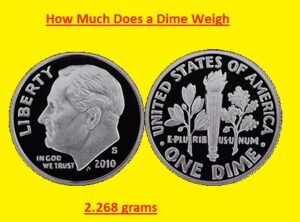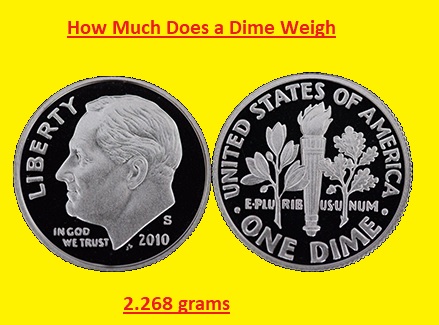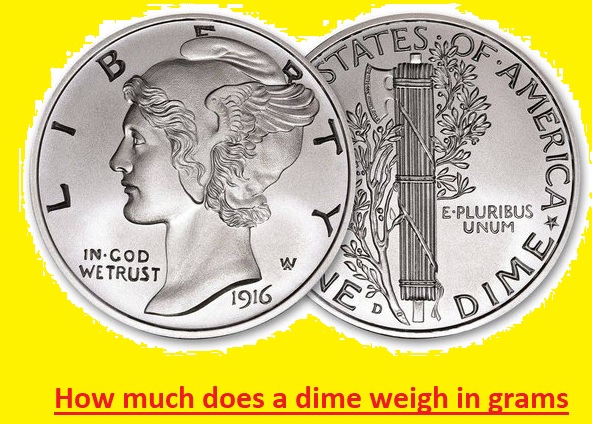 Hello, friends welcome to a new topic. In this post, we will discuss How Much Does a Dime Weigh? This right platform for you to get the right knowledge of dime weight. Different people and coni lovers are interested in learning about the weight of coins. In this post, we will have a detailed look at How Much Does a Dime Weigh? and other related factors. So let’s get started Dime Weight.
Hello, friends welcome to a new topic. In this post, we will discuss How Much Does a Dime Weigh? This right platform for you to get the right knowledge of dime weight. Different people and coni lovers are interested in learning about the weight of coins. In this post, we will have a detailed look at How Much Does a Dime Weigh? and other related factors. So let’s get started Dime Weight.
History of the Dime
- The Time is a ten-cent coin that was made in 1796 in the USA. At that time it was made with silver and eagle at the backside and a bust of a lady liberty at the front end.
- The look of the dime has varied with the passage of them and different presidents’ photos were shown on the coin with time
Dimes from the 1800s to 1900s
In 1837 wreath design changed with the eagle and the seated liberty dime that called Liberty seated dime was in circulation until 1891. Liberty in different types was added on dime until 1946. The weight also varied especially due to increases in silver prices, but finally set to 2.5 grams for a composition of 90 percent silver and 10 percent copper. This weight value was used until the Coinage Act of 1965.
Materials Used to Make Dimes
- Now copper-nickel alloy having 91.67 percent copper and 8.3 percent nickel used for the creation of dimes. With that to have dime unique colour this alloy also provides dimes strength and saves them from corrosion
- Before 1965, dimes were made with alloys of silver and copper that have ninety percent silver and ten percent copper.
- Their historical importance and rarity make them famous is silver dimes are highly prized by collectors.
- To save nickel for World War II dimes were made with unique alloy. The silver dimes were created from 1942 and 1945 with the use of 56 percent copper, 35 percent silver, and 9 percent manganese.
- There are meats used for the creation of dimes but they also have different patterns and markings that shows their value and bases.
- In the current design of dimes there is a picture of President Franklin D. Roosevelt, and on the back side are pictures of a torch, an oak branch, and an olive branch. At the back side of the coin, there is an oak branch, which is the mint mark, which identifies the location of the coin’s creation
DIfferent Types of Dimes
Draped Bust Dime (1796-1837)
This coin first made in 1796 has a design like another silver coin of that dime and also comes with a Draped Bust design. The front side has a photo of Liberty with Hair tied using ribbon. For this coin’s first two years reverse has an eagle perched in the wreath. In 1798 reverse desing varied to the Heraldic eagle. This design made in 1807
Capped Bust Dimes (1809-37)
The US Mint did not make dimes in 1808 but introduced the capped bust dime in 1809. Their front desing was like the older design, and the head of liberty sported a cloth cap. The eagle on the back side of the dime varied with a new design and was perched on a branch with arrows clutched in talon. This design was made through 1837 and not struck yearly basis until 1827.
Liberty Seated Dime (1837-91)
This coin was made in a similar year as the final capped but dimes, Liberty seated coinage marked a departure from the classic close-up. This coin comes with a full-length depiction of Liberty. She holds the pole in her left hand and is seated on a rock. In the right hand is the shield. On the back side, the conventional eagle is replaced with an open wreath surrounding the denomination. In 1978 at the start of 1838, no star was added in the front side but starting of 1838 through 1860 12 stars were added around Liberty. Though the design was changed many times before it stopped, Liberty seated coinage was made until 1891.
Barber or Liberty Head Dime (1892-1916)
In the last year of Liberty, the seated dime dew design of dime started. As a result, in 1892 Charles Barner’s liberty head design was introduced for a dime with a quarter and a half dollars. It is known as a barber dime having a liberty photo on the front side wearing the cap and a Jaurel wreath on the head. The back side was not replaced with the previous design
Mercury or Winged Liberty Head Dime (1916-45)
Adolph A. Weinman’s highly given Mercury design was replaced with Barber dime through 1916. Elsie Stevens wife of Wallace Stevens, is Weinman’s model. His design comes with the head of liberty and in this design has a winged cap for a symbol of freedom. But with the introduction of these coins, it was mistaken for the Roman god Mercury. The reverse design changed with a bundle of sticks with an ax blade and olive branch is in background. The mercury dime was used until 1945.
Roosevelt Dime (1946 to date)
In 1946 Roosevelt’s passing dime design was made. That has a photo of 32 presidents of the US and the reverse design has torches flanked by branches, with denomination below. The country name the United States of America is also on this side. This design currently in use.
What Is a Troy Ounce?
- The troy ounce is used in costly metals to measure the weight of coin bars and bullion products. It is also used in the creation of jewelry and decorative objects created with costly metals.
- The metals also use other units of measurement with the troy ounce, like gram, kilogram, and pennyweight. Due to its historical significance and common industry use, the troy ounce is the measurement unit that is most frequently used.
Why are Dimes so small
- Dies were made with a silver alloy that was high cost so they are small in size than other coins. The size of dimes was reduced by the US Mint in 1837 to save money making them smaller and less weight than other older designs. It reduces the amount of silver needed for every coin still helping mint to produce silver dimes.
- Dime is simple to handle and transport due to its small size. Their small size makes them commonly used for vending machines, automated systems public transit. The dime is a liked coin among collectors as it is small in size, which makes it simple to add to coin rolls and other collections.
- Dime is historically important in American culture despite its diminutive size. President Franklin D. Roosevelt, who worked in the development of many social programs during in office, is shown in the present design. a dime a dozen is used to define what is typical or simple to find. The dime is also a famous luck symbol.
How Much Does a Dime Weigh on a Scale?
- When measured scale, a dime’s weight is 2.268 grams. Due to, wear and tear, or other circumstances, this weight value can be different
- it is good to note dime value is not based on just weight. The value of dime collectors in precious metals can also be affected by a year of mint condition an
- Such as despite the factor that all coines have the same weight the silver dime from twenty century can have a higher value than the copper-nickel dime present. A dime with rare markings, and errors can also be of higher value than an ordinary dime.
- Try to use a scale that is accurately calibrated when finding the weight of a dime. Small weight variations can affect a coin’s value when handling rare or expensive pieces.
The Weight of a Dime
A dime weighs grams is 2.268 grams, or 0.08 ounces, according to the US Mint.
Variations in Weight
- Though dime weight is constant but has changed with time. Such as save nickel for the war effort during World War II dimes were made with unique alloys. These war nickels, known as dime coins, weighed 2.7 grams, or 0.096 ounces
Read Our Latest Electronics Blogs:
How Much Does a Dime Weigh on a Scale
A dime normally weighs 2.268 grams when measured through a scale. But on the base of the age of coins and conditions, weight can be different., a modern dime that has good shape can weigh higher than an older dime that has been worn down through time.
What is the weight of a silver dime in grams?
The silver dime was made in the US in 1965 and created with the use of 90 percent silver and 10 percent copper. The weight of silver dime in grams is based on the type of dime and different dimes made in different years have different weights. The common type of silver dime is the Roosevelt dime first time made in 196. The Rosevelt silver dime weight is 2.50 grams. But before 1946 dimes like Mercury dime and Barber dime had a weight of about 2.20 grams.
How Many Grams is a Dime
- A dime has about 2.268 grams of weight
Measuring the Weight of a Dime
- There are different techniques to measure the weight of dimes
Using a Scale
- A digital scale is an accurate tool for finding a dime’s weight. Place a penny on the scale and measure the weight that is shown.
Other Methods
- the weight of a dime is comparable to that of a paperclip or a single grape.
Types of Dimes
| Type of Dime | Year | Composition | Weight | Diameter | Design |
|---|---|---|---|---|---|
| Bust | 1796 to 1837 | 89.24 percent silver, 10.76 percent copper | 2.7 grams | 19-20 mm | Liberty on the front side, eagle on the back side |
| Seated Liberty | 1837 to 1891 | 10 percent copper, 90 percent silver | 2.49 grams | 17.9 mm | Seated Liberty at back end obverse, wreath on the backside |
| Barber | 1892 to 1916 | 10 percent copper 90 percent silver, | 2.5 grams | 18 mm | Liberty head on the front, eagle on the back |
| Winged Liberty Head (Mercury) | 1916 to 1945 | 10% copper 90 percent silver, | 2.5 grams | 17.9 mm | Winged Liberty Head on the front and, fasces on the back |
| Roosevelt | 1946 to Date | 91.67 percent copper, 8.33 percent nickel | 2.27 grams | 17.9 mm | Franklin D. Roosevelt on the Obverse, torch, olive branch, and an oak branch on the back end |
Interesting Facts About Dimes
- DIme originated from the French word “disme,” which means tenth,
- Franklin D. Roosevelt’s photo was added to a dime for the first time in 1946.
- The USA Mint makes a dime, which is its thinnest coin.
How much do quarters, nickels, and pennies weigh?
The quarter weight is about 5.67 grams, nickel has 5 grams weight and the penny weighs 2.5 grams. The quarter comes with 24.26mm diameter and a thickness is 1.75mm.
Nickle thickness is 1.95 and 21.21mm diameter and pennies are 19.05mm wide with 1.52 mm thickness.
Why is the dime smaller than a nickel or a penny?
In the old days, the weight tof coins was equal to their value in a result dime was worth is ten cents of silver. Five cents value of cents makes small coins that are called half dimes. For practical use metal content of coins varied and half dime became nickel that it was created of nickel
What should a dime weigh on a scale?
The dime has 0.705 inches in diameter and its weight is 2.268 grams. Five cents is 0.835 inches in diameter and eight tis five grams. The one-cent coin is 0.75 inches in diameter and weighs 3.11 grams.
Does a dime weigh 2.3 grams
The currently used dime weight is 2.27 grams and each curent US coin’s weight is larger than dimes.
How much does a penny weigh?
What does 1 dime equal?
A dime is worth 10 cents.
How much does 10 cents weigh on a scale?
How much does a dime weigh in grams
2.27 grams.
What is the average weight of a dime?
| alue | 0.10 U.S. dollar |
| Mass | 2.268 g (0.0729 troy oz) |
| Diameter | 17.91 mm (0.705 in) |
Conclusion How Much Does a Dime Weigh?
In conclusion, a dime comes with copper and nickel metals, and a dime in grams weighs 2.268 grams. Even though the dime’s weight is constant, there have been varying, like that during World War II. If you’re wondering weight of dimes, weigh them on a digital scale or also weigh of paperclip or grape is equal to a dime
.
FAQs
- Are all dimes have the same weight?
- Yes, till that they are altered or damaged, all dimes come with the same weight.
- How correct are estimates of the weight of a dime using everyday objects?
- The weight of a dime can be estimated with common things that can not be as accurate as using a digital scale.
- Is the weight of a dime affect its value?
- The weight of a dime affects its value.
- What is the current design of the dime?
- On the front side of the dime is a picture of President Franklin D. Roosevelt, and on the back side there are pictures of a torch, an oak branch, and an olive branch.
- Why was a special alloy used for dimes during World War II?
- As nickel was a costly metal required for the creation of military equipment, the special alloy was used to preserve nickel for the war effort.
Read also:








